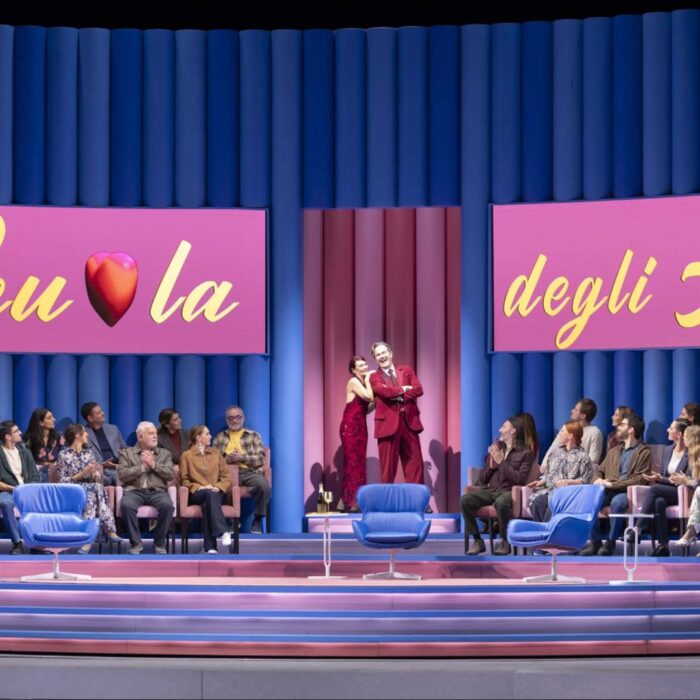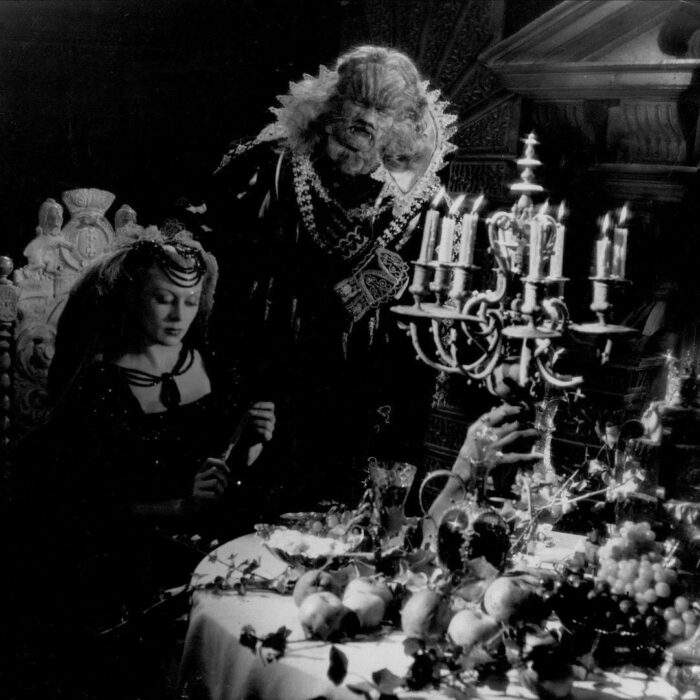
Festival Aix-en-Provence 2025 Review: La Calisto
By João Marcos Copertino(Photo: Monika Rittershaus)
By the middle of the second act, a third of the audience had already gone home. They were not necessarily bored—some complained that the seats were too harsh on their spines; others that, because the opera started so late, they were unwilling to return home well after midnight. The fact is, this production of “La Calisto” did not seem to be worthy of much sacrifice.
The lack of commitment to stay until the end of the opera had little to do with “Calisto’s” inherent appeal. Since its revival in the 1970s under the baton of Raymond Leppard, Cavalli’s “Calisto” has been a cornerstone of the early music movement and has attracted many successful performers (René Jacobs, Ileana Cotrubaș, María Bayo, Simon Keenlyside, Dame Janet Baker, to name a few). The lack of appeal in this Aix production of the Venetian opera had little to do with shortcomings in Cavalli’s score or Giovanni Faustini’s libretto, and more to do with the direction team’s apparent misunderstanding of what “Calisto” does best.
The staging, directed by Jetske Mijnssen, cloaked the ancient Greek myth under a “Dangerous Liaisons” aesthetic—more inspired by Stephen Frears’ film than Laclos’ original novel. Despite the glossy costumes and subtle sets, Mijnssen ignored essential conventions of social stratification crucial to representing sexual desire.
Sex was not always the same. Back in the day—or across millennia—when gods raped mortals, the exploitation of power was essential to the construction of desire. It does not take much to understand this—just open any page of Ovid’s Metamorphoses, where the story of Calisto originates. By dressing Calisto in similar garments as Juno and Diana, Mijnssen erased any markers of social difference—except for gender, of course.
Mijnssen seemed interested in breaking representational pacts. In this staging, Linfea is performed by a tenor, for example. But the erasure of social distinctions—between servants and nobles, gods and mortals—prevents the audience from truly engaging with “Calisto’s” plot. After all, what is problematic about the love between Diana and Endimione if they are equals? And how credible is it to see Jupiter impersonate Diana if he is not magically transformed? Are we supposed to believe that Calisto is as naive as the ladies in “Così fan tutte” and fails to recognize a drag version of her goddess?
Throughout the staging, inconsistencies emerged that could have been avoided had Mijnssen grasped the significance of social class. In fact, much of the injustice and tragedy in “La Calisto” is explainable only through class struggle. Even more troubling, the production’s liberal and seemingly militant queer approach loses meaning when disconnected from the implications of Calisto’s sapphism and mortality. She is not punished for being desired by Diana, but for being desired by Jupiter.
At the end, when, in this production, Calisto ascends to the sky after stabbing and killing Jupiter, I was perplexed by the sheer inexplicability. Was the refusal to depict class struggle merely a setup to render Jupiter mortal and allow for his punishment? Does the production portray Calisto as blind and somewhat foolish solely to justify punishing Jupiter, rather than engaging with how unfairness shapes the tragic? For a literature major, it felt as if Mijnssen had skipped a few crucial lessons.
Another issue was that Sébastien Daucé did not seem fully conscious of the acoustic conditions of the Théâtre de l’Archevêché. For those unfamiliar with the venue, it’s a medium-sized theater in the courtyard of an ancient building (now housing the tapestry museum). The acoustics are good, but there is no roof, so the orchestra occasionally has to compete with birds and bugs.
Last night, however, the problem reached another level. The mistral wind was stronger than usual, and even an airplane passed overhead—something I do not recall ever happening before. A lute or theorbo can barely be heard in an acoustically isolated hall; imagine when it’s up against a Rolls-Royce engine… It would have been better to do as they did last year with Monteverdi, and perform Cavalli in the Théâtre du Jeu de Paume.
The orchestra seemed too small for the venue and too large for Cavalli. Most of the subtle nuances, comic effects, and shivering strings were lost. The entire first act—including the famous “Jupiter in travesti” scene—felt longer than the opera itself, and it was hard to remain engaged. The orchestra reached a truly moving pianissimo only once, in the third act, during Juno’s ominous aria.
The voices, though all well-suited to the repertoire, were not always in their best form—especially given the demands of the score and the venue.
Let’s start with the night’s star: Lauranne Oliva sang Calisto with that piercing, bright voice now so associated with seventeenth-century repertoire. Her first entrance already revealed how she would portray the character for the rest of the evening—good-hearted, a bit ingénue, but tragically lost and confused about most things.
I’ve been extraordinarily impressed with the versatility of Oliva’s voice. Not long ago, I heard her sing a “Caro Nome” in full lyric mode, and also perform Poulenc fragments with a nuanced balance of clear French and a charming quick vibrato reminiscent of Denise Duval. In “La Calisto,” Oliva offers something else. Her voice retains a lyrical core, but she controls her vibrato remarkably. For those in the audience, several moments were particularly charming—especially her first entrance and her aria in the third act.
Another versatile singer was Alex Rosen as the formidable Jupiter. His role presents two clear challenges: making an amoral character somewhat likable, and being both funny and compelling while singing in falsetto as Diana. Though the staging made both tasks harder, I believe Rosen was competent and—by the third act—quite successful. His falsetto is resonant and mellifluous, and his bass voice never descended into the cavernous tone that feels out of place in Cavalli.
Giuseppina Bridelli’s Diana was a layered portrayal. Significantly cold in the first act, Bridelli softened her tone beautifully when revealing her affection for Endimione. Their duet at the beginning of the second act was so effective that it justified the unusual entr’acte break, which took place immediately after instead of at the end of the act.
Perhaps the evening’s greatest pleasure came from hearing Paul-Antoine Bénos-Djian as Endimione. If I had to recommend a countertenor to someone unsure about the voice type, Bénos-Djian would be my choice. Beyond his technical skill, he conveys a youthful, pubescent masculinity uncommon in countertenors. His Endimione combined lyricism with charm and vocal allure, making him the most engaging of the mortals.
Another highlight was Anna Bonitatibus as Juno. Her voice may not have been the purest, and her character was arguably the most merciless, but her legato and exquisitely tender pianissississimo in the third act actually made me melt. How many singers can make the most vindictive woman on stage sound like a victim while she victimizes someone else?
The role of Pan— famous particularly for his first-act aria—was sung by David Portillo. I cannot say whether it was the staging or the musical direction that neutered the character, but a typically showstopping role became forgettable. There were few moments that conveyed either desire or struggle.
What I expected from Pan, we instead got from Dominic Sedgwick’s Mercurio, who had more stage presence and, with his unusually high voice, preserved a kind of panache.
Casting a tenor, Zachary Wilder, as Linfea was an interesting choice. The gender-crossing aspect, however, risked portraying the character as either a mockery of trans people—constantly seeking love but always rejected for their queerness—or as a disservice to a veteran singer better suited to later repertoire (especially Handel).
Overall, although mostly well-intentioned, “La Calisto” demonstrated how much misunderstanding a few elements can make even one of the most intriguing operas in the repertoire difficult to watch.


